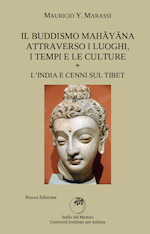The invention of “zero”
When Nāgārjuna says: “the self nature of Buddha is the self nature of this world (A= B). But Buddha’s self nature is empty (A=0); therefore empty is the self nature of this world (B=0)” is as if he “divided by zero” the first proposition with the second. “Emptiness of self-being” is the English translation of svabhāvaśūnyatā, where svabhāva stands for “nature/essence/intrinsic and inherent existence” and śūnyatā stands for “emptiness/vacuity”. Sūnyatā is the substantive form of śūnya which, besides empty, also means “zero”, and in fact, is the etymological root of the word “zero”. So, in this case Buddha is the self-consciously empty existence. It is something and it is zero at the same time.
Buddhism, specially Nāgārjuna’s Buddhism, does not produce theories but speaks to me and speaks about my life. We must squeeze all of ourselves into this process. And if we do, we find that “When I am in life-and-death (samsāra) and I intimately perceive (manasikāra) the miracoulous void of every thing that comes into existence (pratītyasamutpāda), living, being born, suffering and dying disappear (because the subject of these verbs lives on as an empty form, a “zero”). If I, living, being born, suffering and dying (in samsāra) identify myself with emptiness/śūnyatā (or: if I perceive that there is no Buddha because I/he am/is an empty form), I do not delude myself (where there is nothing besides zero and emptiness, there is no space for delusion and deception) about living, being born, suffering and dying”.
The two original sentences can be reconstructed in the same way. “If there is no Buddha in life-and-death, there is no life and there is no death” and “Buddha in life-and-death means not being deluded about life and death”. Keep in mind that the essence of Buddha is the essence of this world. If Buddha does not exist, it is because we perceive the emptiness of the essence of life and, and if that is so, so it is for all things and for each of them. If Buddha lives or exists even in the peculiar manner in which all reality exists, then every thing exists.
To round up the argument, it follows from: “The essence of Buddha is the essence of this world” that also these sentences are true: “If there is Buddha in life-and-death, there is life and there is death” and “Buddha in life-and-death means deluding oneself about life and death”. In this case, Buddha exists, and that happens when I attribute to myself an independent and sovereign life and existence, when I do not regard myself as an empty form, but a form full of myself, in fact a form bursting at the seams. When this occurs, I drift into the infinite, cramped time-space called samsāra. Buddha here has the same meaning it has in the expression “if you encounter Buddha, kill him!”.
The relevance of these ideas for the lives of those who, like ourselves, attempt to follow in the footsteps of these ancient sages is sealed by this other sentence by Dōgen: “Understand with the utmost clarity: life and death, our nirvāņa”. This sentence recalls the 19th and 20th verses of the 25th chapter of Madhyamakakārikā : “19. between empirical existence (samsāra/shōji) and nirvāņa there is no difference whatsoever. Between nirvāņa and empirical existence there is no difference whatsoever. 20. What is the boundary of nirvāņa that is the boundary of empirical existence. There is no difference whatsoever between them.”
I have discussed elsewhere (11) how and why hell and heaven, nirvāņa and this life are equal and, at the same time, radically different. Now instead, the point I want to make is about Dōgen’s glasses. The glasses Dōgen wore to read Buddhism – which are the glasses we must wear ourselves to understand him – are the same teachings as Śākyamuni’s and Nāgārjuna’s. I am convinced that this is so because they held the same view of pratītyasamutpāda. One of the oldest sūtra, the Śālistambasūtra the Discourse on the rice plant says: “Once Maitreya, the Blessed One, seeing a rice plant sprouting gave this speech to the monks: «O monks, he who sees the pratītyasamutpāda sees the dhārma, he who sees the dhārma sees the Buddha».
Dōgen lived far from India, where Buddhism developed, and was not in contact with any of its contemporary proponents. He could not draw directly from the source. He knew it only indirectly through the words of the patriarchs and the Chinese translators. But – and this is fundamental –he had practiced with utmost commitment the zazen he had been taught in China by Tiantong Rujing, one of the transmitters of the Chan/Dhyāna tradition, the art of disappearing while living life in its most intimate essence.
The relentless practice of the right way of doing zazen, which was the same yoga/dhyāna/Chan/Zen practiced by Buddha under the tree of the awakening, allowed him to see beyond words, and to recognize, among the many doctrines that claimed to be the true foundation of Buddhism, just the teaching called pratītyasamutpāda, which is the only teaching that is in true harmony with the deepest knowledge of self. This teaching remains the warp of every Buddhism – warp that must be woven with the weft of the daily living according to ahimsā/maitrī/in-nocence/brotherly-love, on the base of the daily practice of zazen.
Foot note
11) Cfr. M.Y.Marassi, Il buddismo mahāyāna attraverso i luoghi, i tempi e le culture. L’India e cenni sul Tibet, Marietti, Italy 2006, 39, 62 s., 130, 179 s., 183, 221.
(By Mauricio Yūshin Marassi, La Stella del Mattino Zen Buddhist Community. Translated into English by Carlo Geneletti)
Se volete, lasciate un commento.
You must be logged in to post a comment.







